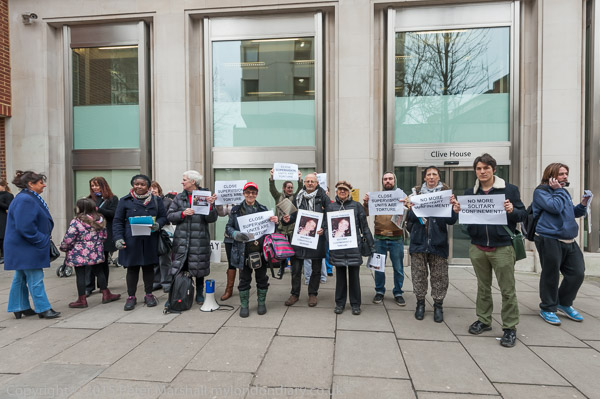
Before entering the notorious Close Supervision Centre (CSC) system back in 2010 I had very little knowledge of either segregation or solitary confinement. Having just turned 23 years of age and having spent as little as two and a half of those years in prison, my mind had never had been focused on or even interested in this topic. Now, midway through my seventh year of isolation things have changed; the horrors I have witnessed over this period have left me with little option but to become fully aware of the devastation even short periods in these conditions can have.
For those who have not experienced solitary confinement, there are no words or description which could allow you to fully comprehend what it means. I should probably start by explaining that in official terminology ‘solitary confinement’ equates to at least 22 hours a day locked away, with every hour of the day spent in isolation from other prisoners; whereas, ‘segregation’ is the removal from normal location without specified conditions. Generally speaking, both amount to the same thing, due to the harshness of segregation units within this country. The CSC is commonly described as a prison within a prison; it allows for indefinite isolation of prisoners under the most oppressive conditions. Effectively, permanent segregation, almost always meets the definition of solitary confinement and it is from here that I bring you my voice.
The Prison Reform Trust (PRT) did some good work with their February 2016 report, entitled Deep Custody, although, they could never truly reflect the dire reality of life in this appalling environment without living it themselves. The common belief is that prisons in England are holiday camps where human rights have led to things being too easy for prisoners, but this propaganda in no way relates to the facts, as most clearly demonstrated by the deplorable way prisoners in segregation are treated. Routinely abused by prison officers appointed to look after their care needs, starved, assaulted and made to live in filthy cells, made of nothing more than an empty concrete box, wearing the same clothes day in and day out; a holiday camp offering this would not sell many tickets.
One day, less than six months after first being placed in the CSC, another prisoner who had been unfortunate enough to be located in HMP Woodhill CSC unit along with the rest of us (never totalling more than ten) had been struggling to cope since his arrival a few weeks earlier. He complained of the difficulties he was having and was directed toward the psychiatrist, who duly prescribed medicine to help him survive the CSC. As the effects wore off he continually required higher dosages. Eventually, the drugs were not enough; he began to hear voices and took action to put a stop to them. Using a prison issue razor he sliced off one of his ears out of pure desperation. Even this did not resolve his problem. Pumped full of anti-psychotics and anti-depressants, anti-anxiety drugs and sleeping pills the CSC did not go away for him. About six weeks later he removed his other ear.
This man had been totally fine in the beginning; he simply crumbled beneath the weight of pressure being in solitary confinement puts on a person.
The official objective of the CSC is to reduce the alleged risk factors of the prisoners detained within it and then return them to mainstream prison population. However, the statistics show a darker picture. More than half of all prisoners who enter the CSC are driven insane before being removed to a psychiatric hospital. Fewer than 10% actually ever return to normal conditions. The question therefore is not what alternatives are there but why is this being allowed?
Self-mutilation is one symptom but, dealing with extreme environmental stress manifests itself in many ways, most of which are unhealthy. You would think that the few prisoners lumped together in these places would form some kind of solidarity to overcome their shared ordeal but, instead, an irrational hatred for everything forms, or they attempt to appease their guards by joining in with the victimisation of a particular individual.
Racism is more prevalent in the CSC among those who have suffered there the longest. It is an outlet to focus their rage when the faceless bureaucrats responsible for inflicting the harm upon them are out of reach. It is encouraged by prison officers. I am also certain that discriminatory views are developed fastest and held most strongly by those who spend their meagre allowance purchasing tabloid newspapers; this says something about the weakness of mind of the prisoners held in these conditions, leaving them open to manipulation.
The dangers of containment in such units, have, however, always been known of, which is why prisoners of war have deliberately been subject to such treatment. Amnesty International has previously condemned Britain’s use of special units in its report, United Kingdom Special Security Units: cruel, inhuman or degrading treatment? And, this was in relation to a previous variation which operated a less oppressive regime than currently exists.
Desperation consumes so many prisoners held in solitary confinement, leading to desperate acts. In 2015 at Woodhill CSC one man even began the transition to become female, purely to escape the dreadful environment. He then committed suicide before achieving his goal, as he was no longer able to tolerate the constant harm.
This is not humane, yet steps are being taken to expand the use of segregation through the creation of what are being called Separation Centres (SCs), aimed specifically at the minority group of Muslim prisoners.*
The first instalment of the SC system has opened on E wing at HMP Frankland in Durham. The wing, which was formerly used to house elderly prisoners, is now an SC for those deemed to present a threat – either in person or by influencing others – which cannot be managed within mainstream population. The elderly prisoners have been left to fend for themselves on a normal wing.
E wing contains 16 cells. It is not yet clear if all of them will be utilised. The wing has been refurbished, to include hidden microphones for covert surveillance and the transformation of one of the segregation exercise yards – which will now be used only by those on the SC – by adding barriers to isolate it further.
A gym is located on the wing since the prisoners will not be allowed to access normal facilities. However, it seems that only basic cardiovascular equipment like a running machine and rowing machine are available. Prison Service Instruction 05/2017, which governs the SC system, claims that ‘The Supervision Centre Regime is as broadly comparable to the mainstream population as is possible, with individual risk assessment informing activity and management of the prisoner’; however, this is exactly the same basis on which the CSC regime, which can best be described as indefinite solitary confinement, operates.
The SC system is blatantly an unofficial CSC system designed to specifically discriminate against Muslim prisoners who are disliked but have not actually done anything to justify a CSC placement. Since the ruling in the Supreme Court case of Bourgass, concerning holding Muslim prisoners arbitrarily in isolation in segregation units, prison management has been planning a way round it – hence the SC system.
From at least as far back as the mid-1990s, and probably before, the Prison Service has been fully aware that holding prisoners in these conditions is detrimental to their physical and mental health. In 1996 Chief Medical Officer Sir Donald Acheson completed a report on the effectiveness of the SSUs which contained the then hated and demonised Irish prisoners of war. The creation of the SC system can therefore be seen as a direct attack and deliberate act of harm by those legally bound to maintain a duty of care against those who today oppose their political views.
The financial cost of inflicting this harm upon each SC or other control unit prisoner is more than four times the cost per prisoner held on normal location. At a time when the prison system is in crisis through underfunding and is struggling to cope with excessive numbers of prisoners, for exorbitant amounts to be found solely for these invidious purposes, makes clear how little the welfare of prisoners really matters to those operating and managing prisons. The sooner an end to this massive waste of public money occurs, the better.
The total abolition of the CSC solitary confinement and segregation units is the only way to end this insidious destruction of human minds and lives.
Kevan Thakrar (prison number A4907AE)
Close Supervision Centre, HMP Woodhill, Tattenhoe Street, Milton Keynes, MK14 4DA
www.justiceforkevan.org
www.Facebook.com/JusticeForKev




